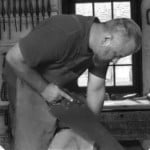Side table – Form/function/design and customer satisfaction
Welcome! / Forums / General Woodworking Discussions / Projects / Side table – Form/function/design and customer satisfaction
- This topic has 27 replies, 6 voices, and was last updated 8 years, 1 month ago by
 António.
António.
-
AuthorPosts
-

Hi fellow readers!
(if I got some…. hopefully)Its been a wile since my last topic in the forum. But this time I’ve been intrigued by th design aspect of designing an object considering all these things:
– The Form,
– The Function,
– The overall design (I know this word has a LOT of meanings all over the world)
– The customer satisfaction!And I mean from a hobby/amateur woodworker.
So my example case:
My wife’s birthday is next week, and she had one idea to get “something” to a particular space of the house. After a lot of debate she liked one drawing – the first picture.
So I went down stairs and started to make it, like a good husband I am 🙂But last week,
– I wanted to add tapper legs for the sake of the “looks more delicate/fancy” – but its all recycled pine and it don’t offer the appropriate support for what it supposed to be.
– She like the legs like that, but wanted “something” on the side and on the front – I suggest some round tapper rails (like a broom stick). We both agreed.
– “We” added a little front drawer… (my 1st one – yet to be born)
Today I’m working on the changes.Disclaimer:
1 – I know that if we work to ourselves is one thing, but working for a client (even if its the wife) then our work is on a very different championship.
2 – I read a LOT of things about design, from pros to guys like me
3 – Not always we can prototypes of the object for our “customers approve” and after that they can/will change their minds. 🙁
4 – I think that I’m missing something.So my question to you all: How to balance all those things in a good, reliable, durable object?
Attachments:
You must be logged in to view attached files. 13 February 2016 at 12:19 pm #134747
13 February 2016 at 12:19 pm #134747I would suggest to look around the internet, through home magazines, visit furniture stores and do this over several weeks. Mark down what you like and don’t look at it for a week, if you still like it start narrowing down to the ones you like the most and then think about the likes and dislikes of it and see what you can change to suit your own tastes. This is the time you start to personalise your creation to make it your own. Then start the drawings, check and recheck your drawings before committing to them. I usually like to come back to them over a two week period as I know I will find errors, miscalculation and will make additions or subtractions to change the overall design. Sometimes even during the build I will make new additions and changes in cad for a new and improved version of it for my next build.
You asked a difficult question which only you can answer over time.

@salko
Thanks for your input SalkoYes, I believe its a very trickie, personal, extremely subjective question.
Lets face it “there’s nothing new under the sun” right?
Its hard finding the right balance between what we already saw, “copying” or get inspired by this bit here or that over there and creating something “new” and to please our customer (who ever they might be)!
 13 February 2016 at 2:06 pm #134750
13 February 2016 at 2:06 pm #134750You know the old saying “you can’t reinvent the wheel” car manufacturers are a classic example of this they just copies each others designs and modifies them.
Look at organic furniture someone wasn’t asleep and noticed the beautiful natural flow of a tree then brought that into his design. When you think it about it wasn’t his design but God’s, the artist just got inspired about an existing design and took all the credit for it, now everyone’s’ doing it.
I’m yet to see a design that’s completely original. Just look around you there’s plenty of wondrous designs to get inspired by.
 13 February 2016 at 2:39 pm #134751
13 February 2016 at 2:39 pm #134751First, copying is how most furniture throughout history was made. That is why antiques can be classified by period, region and style. So don’t get too obsessed with whether or not your “copying”.
Second, your own “voice” will work its way into the items that you make on its own over time. It is something that cannot be forced. For me, it just sort of happened as part of the learning process and can also be a result of your particular set of tools, as well as your interests. For myself, that has worked out to be texture, scratched decoration and incorporating knot tying and rope work.
I can also echo Salko’s advice. Look at as many examples of furniture as you can. I have thousands of photos saved on my coputer that are photos of entire pieces as well parts of pieces that interest and/or inspire me.
Design is process that you will develop over time as your skill and experience develope. It will be ever changing as you grow in your woodworking, but certain elements will emerge that brings your particular style to every piece that you make. Your own “voice”, so to speak.
One last thing, none of the above will be of any use unless you have the confidence to build things your way. Believe in your vision for a piece and have the confidence to execute it. The fact that your asking the questions tells me that you are well on your way to developing your own “voice”
Great topic!
 13 February 2016 at 7:10 pm #134760
13 February 2016 at 7:10 pm #134760Salko, I totally agree that the particular wood used has to have a say in the design. As a wood turner, I’ve often felt that I was merely uncovering the object that was inherently present in the material used. This has led to some wonderful surprises, which I can take no credit for.
I don’t think I have ever built anything from a measured drawing. I’ll look at plans and photos etc. for inspiration, or my wife will show me a photo of something she likes. I’ll then build the project in my head several times until I’m satisfied. I like to have the wood that I’ll use for the project available as well, so I can see how that fits. I’ll generally work from a rough sketch for dimensions etc. and details may change as I’m building. I have the advantage of not having clients to satisfy and my wife has generally been pleased with what I’ve come up with. There are a few times that what I’ve produced is firewood, but that’s a learning experience as well.

Thanks Greg and Salko!
I’m aware answering this question will be a marathon and not a sprint, nevertheless some different ideas, new angles, will be very appreciated!Meanwhile today:
I looked to my wood pile… tried to listen to my interior voice, and spotted the broom sticks and some “dowels” (previous form – the youngest baby crib). The wood is all recycled!The size was exactly 15mm like my forstner bit. What a lovely title tenons that’s going to be…
But since this morning the glue didn’t dry yet! Lots of humidity and moister in the air. So I’ll wrap this and headed to cook dinner!
Attachments:
You must be logged in to view attached files.
 13 February 2016 at 11:32 pm #134771
13 February 2016 at 11:32 pm #134771Plans work well in the machinists world as machines for mass production you set it and forget it and each joint should fit together seamlessly but not so for hand toolers. You must mark each piece individually otherwise they will not come together but even though I hand tool I don’t make one off items most of them are repeats or multiples so I need to draw up plans for everything I make. It also serves as a guidelines you know takes all the guess work out of woodworking. Usually I always cut a little oversized and then trim parts to fit in case I did stuff up some where along the line.
I didn’t know George you are a wood turner I was once a member of a wood turners club but unfortunately I never learned much there at all. I would like to turn a lot more than I do I’m always rusty when I come to the lathe. At one time I turned everyday for two weeks and my skills increased but then nothing after that for months and got all rusty again. I think I will have to set a day dedicated just to turning and hone this important skill.
14 February 2016 at 1:36 pm #134781Antonio,
For me, design comes either from desired function or from available material.
That is, the desired function plus what you know about furniture and your technique shall give you some inspiration to go in the direction of your customer´s wishes.
But also available material, as a limitation, gives you an input to proceed in some way (and not in any other way).
Usually, I don’t draw all the details before starting a project. The basic lines and structure are defined and some things are worked out during production.
Of course, you should not go back and forth. The main concept cannot be changed afterwards, but embellishments can be added.

After the 1st coat of (lemon) shellac I decided to give it a try on the place it will be!
Still have a few thins to work it out (I’d love it looked more “light”) And I couldn’t help some tear out. Even sharpening a lot! That knotty&naughty pine 😛
The drawer is next!
But overall it does what it supposed to do.Keep our opinions coming!
A couple of pictures.
Attachments:
You must be logged in to view attached files. 16 February 2016 at 9:38 pm #134828
16 February 2016 at 9:38 pm #134828That’s looking pretty good! The rounded edges on the top really help to lighted the look.
As for the legs, something like what Mr. Sellers does on the bench stool project might be what you’re looking for. He also used the same effect on the chair side table in his book. It lightens the look considerably, with out affecting the structure.
 16 February 2016 at 11:01 pm #134829
16 February 2016 at 11:01 pm #134829It looks good Antonio!
Even a little shaping of the leg will make a dramatic difference in the lightness of the look. Grab a few scraps and play around with different shaping ideas. I’ll also put in a vote for what Paul has done on past projects. I’ve used that technique several times and really like it. 16 February 2016 at 11:37 pm #134830
16 February 2016 at 11:37 pm #134830I agree with both Peter and Greg you should give some shape to the legs unless you do like it as it is.
I like your comment knotty & naughty pine,
-
AuthorPosts
- You must be logged in to reply to this topic.
